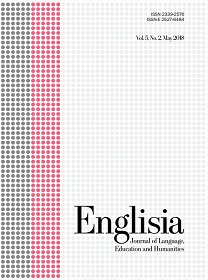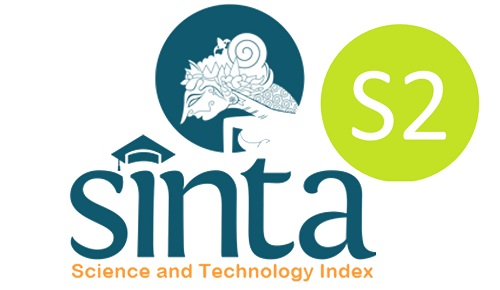The development of syntactic complexity in university students’ essays
DOI:
https://doi.org/10.22373/ej.v11i1.19129Keywords:
Second Language Writing (SLW), Syntactical Complexity, Essay, L2SCAAbstract
This research aimed to describe quantitatively the development of students’ syntactical complexity during the Essay Writing Course measured with the L2SCA tool by Lu. The research basically implemented a descriptive-quantitative research design. The primary data were collected from 20 students majoring in Agribusiness and taking an essay writing course in Yogyakarta Muhammadiyah University (UMY) during one semester from February to July 2022 in a researcher class. They wrote three essays gradually from one session to the third session of the class. The essays were analyzed quantitatively using the L2SCA tool by following the indices of the tools as the reference to see the students’ syntactical complexity. In addition, the participants wrote three essays divided into three times writing tests. Overall, the analysis method was conducted by following a systematic procedure; classifying, scoring, displaying, describing, interpreting, discussing, and concluding. As a result, this study reveals that syntactical development of students’ essays during a semester session of writing course fluctuated from the first writing until the third writing. Although along the writing supervision, they had consultation sessions, the result did not show gradual and constant progress. It implied that the students’ acquisition of syntactical complexity represented in writing did not improve progressively in all syntactical indices. However, among the three essays the participants wrote, they excel most in second essay or argumentative essay. Further, it is necessary to relate the essay’s genre to the result of students’ writing for each of the essays has a special characteristic and level of difficulty.
Downloads
References
References
Abdi Tabari, M., & Wang, Y. (2022). Assessing Linguistic Complexity Features In L2 Writing: Understanding Effects Of Topic Familiarity And Strategic Planning Within The Realm Of Task Readiness. Assessing Writing, 52. Https://Doi.Org/10.1016/J.Asw.2022.100605
Bi, P., & Jiang, J. (2020). Syntactic Complexity In Assessing Young Adolescent Efl Learners’ Writings: Syntactic Elaboration And Diversity. System, 91. Https://Doi.Org/10.1016/J.System.2020.102248
Bulté, B., & Housen, A. (2014). Conceptualizing And Measuring Short-Term Changes In L2 Writing Complexity. Journal Of Second Language Writing, 26, 42–65. Https://Doi.Org/10.1016/J.Jslw.2014.09.005
Cotos, E. (2014). Genre-Based Automated Writing Evaluation For L2 Research Writing.
Crossley, S. A., & Mcnamara, D. S. (2012). Predicting Second Language Writing Proficiency: The Roles Of Cohesion And Linguistic Sophistication. Journal Of Research In Reading, 35(2), 115–135. Https://Doi.Org/10.1111/J.1467-9817.2010.01449.X
De Clercq, B., & Housen, A. (2017). A Cross-Linguistic Perspective On Syntactic Complexity In L2 Development: Syntactic Elaboration And Diversity. Modern Language Journal, 101(2), 315–334. Https://Doi.Org/10.1111/Modl.12396
Frantz, R. S., Starr, L. E., & Bailey, A. L. (2015). Syntactic Complexity As An Aspect Of Text Complexity. In Educational Researcher (Vol. 44, Issue 7, Pp. 387–393). Sage Publications Inc. Https://Doi.Org/10.3102/0013189x15603980
Godwin-Jones, R. (2018). Second Language Writing Online: An Update. Language Learning & Technology, 22(1), 1.
Gustin, S. (2019). Differences In Syntactic Complexity In The Writing Of El1 And Ell Civil Engineering Students Differences In Syntactic Complexity In The Writing Of El1 And Ell Civil Engineering Students By A Thesis Submitted In Partial Fulfillment Of The Requirements For . June.
Hockly, N. (2019). Automated Writing Evaluation. Elt Journal, 73(1), 82–88. Https://Doi.Org/10.1093/Elt/Ccy044
Jagaiah, T., Olinghouse, N. G., & Kearns, D. M. (2020). Syntactic Complexity Measures: Variation By Genre, Grade-Level, Students’ Writing Abilities, And Writing Quality. In Reading And Writing (Vol. 33, Issue 10). Springer Netherlands. Https://Doi.Org/10.1007/S11145-020-10057-X
Johnson, M. D. (2017). Cognitive Task Complexity And L2 Written Syntactic Complexity, Accuracy, Lexical Complexity, And Fluency: A Research Synthesis And Meta-Analysis. Journal Of Second Language Writing, 37, 13–38. Https://Doi.Org/10.1016/J.Jslw.2017.06.001
Kang, S., & Lee, J. H. (2019). Are Two Heads Always Better Than One? The Effects Of Collaborative Planning On L2 Writing In Relation To Task Complexity. Journal Of Second Language Writing, 45, 61–72. Https://Doi.Org/10.1016/J.Jslw.2019.08.001
Li, J., Link, S., & Hegelheimer, V. (2015). Rethinking The Role Of Automated Writing Evaluation (Awe) Feedback In Esl Writing Instruction. Journal Of Second Language Writing, 27, 1–18. Https://Doi.Org/10.1016/J.Jslw.2014.10.004
Lu, X. (2010). Automatic Analysis Of Syntactic Complexity In Second Language Writing. International Journal Of Corpus Linguistics, 15(4), 474–496. Https://Doi.Org/10.1075/Ijcl.15.4.02lu
Lu, X., & Ai, H. (2015). Syntactic Complexity In College-Level English Writing: Differences Among Writers With Diverse L1 Backgrounds. Journal Of Second Language Writing, 29, 16–27. Https://Doi.Org/10.1016/J.Jslw.2015.06.003
Mazgutova, D., & Kormos, J. (2015). Syntactic And Lexical Development In An Intensive English For Academic Purposes Programme. Journal Of Second Language Writing, 29, 3–15. Https://Doi.Org/10.1016/J.Jslw.2015.06.004
Miranty, D., & Widiati, U. (2021). Automated Writing Evaluation (Awe) In Higher Education: Indonesian Efl Students’ Perceptions About Grammarly Use Across Student Cohorts. Pegem Egitim Ve Ogretim Dergisi, 11(4), 126–137. Https://Doi.Org/10.47750/Pegegog.11.04.12
Norris, J. M., & Ortega, L. (2009). Towards An Organic Approach To Investigating Caf In Instructed Sla: The Case Of Complexity. Applied Linguistics, 30(4), 555–578. Https://Doi.Org/10.1093/Applin/Amp044
Nur, U., & Sulistyani, L. (2019). The Analysis Of Syntactic Complexity And Grammatical Accuracy In Unisbank Students’ Writing Thesis In Partial Fulfillment Of The Requirements For Master Degree In Linguistics.
Qian, L., Yang, Y., & Zhao, Y. (2021). Syntactic Complexity Revisited: Sensitivity Of China’s Aes-Generated Scores To Syntactic Measures, Effects Of Discourse-Mode And Topic. Reading And Writing, 34(3), 681–704. Https://Doi.Org/10.1007/S11145-020-10087-5
Stevenson, M., & Phakiti, A. (2014). The Effects Of Computer-Generated Feedback On The Quality Of Writing. Assessing Writing, 19, 51–65. Https://Doi.Org/10.1016/J.Asw.2013.11.007
Sulistyani, U. N. L. (2019). The Analysis Of Syntactic Complexity And Grammatical Accuracy In Unisbank Students ’ Writing. Diponegoro University.
Wang, Y. J., Shang, H. F., & Briody, P. (2013). Exploring The Impact Of Using Automated Writing Evaluation In English As A Foreign Language University Students’ Writing. Computer Assisted Language Learning, 26(3), 234–257. Https://Doi.Org/10.1080/09588221.2012.655300
Zhai, N., & Ma, X. (2021). Automated Writing Evaluation (Awe) Feedback: A Systematic Investigation Of College Students’ Acceptance. Computer Assisted Language Learning. Https://Doi.Org/10.1080/09588221.2021.1897019
Downloads
Published
Issue
Section
License
Proposed Policy for Journals That Offer Open Access
Authors who publish with Englisia journal agree to the following terms:
- Authors retain copyright and grant the journal right of first publication with the work simultaneously licensed under a Creative Commons Attribution License that allows others to share the work with an acknowledgement of the work's authorship and initial publication in this journal.
- Authors are able to enter into separate, additional contractual arrangements for the non-exclusive distribution of the journal's published version of the work (e.g., post it to an institutional repository or publish it in a book), with an acknowledgement of its initial publication in this journal.
- Authors are permitted and encouraged to post their work online (e.g., in institutional repositories or on their website) prior to and during the submission process, as it can lead to productive exchanges, as well as earlier and greater citation of published work (See The Effect of Open Access).









